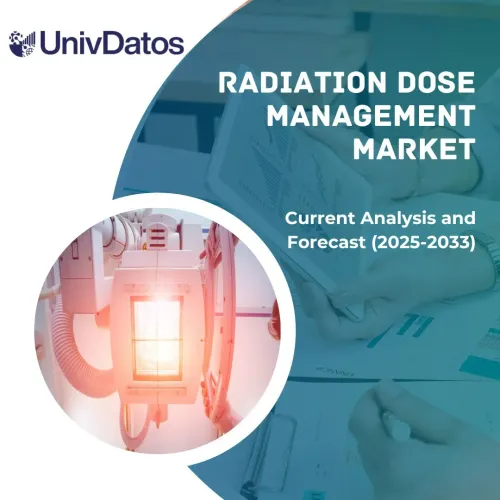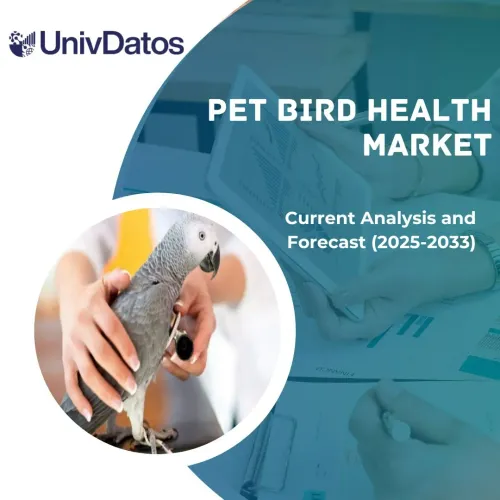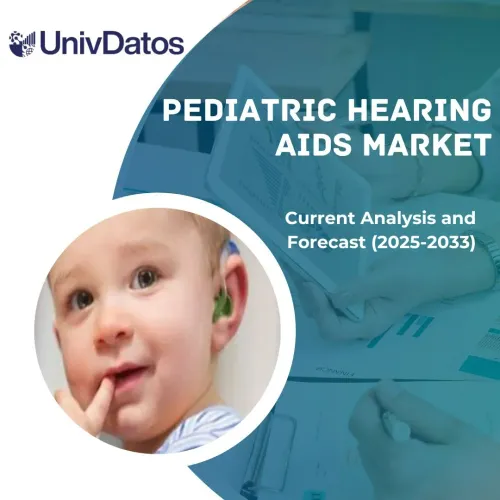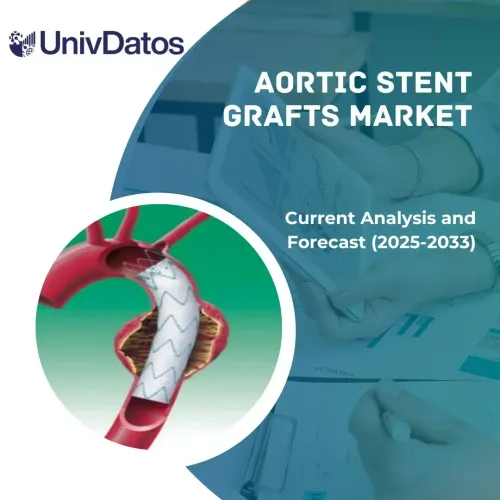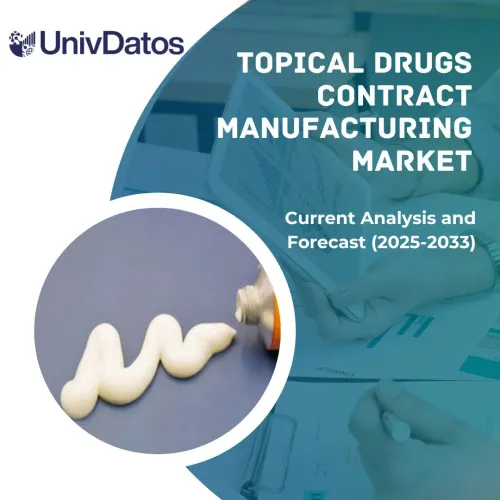- Home
- About Us
- Industry
- Services
- Reading
- Contact Us
Molecular Diagnostics Market: Current Analysis and Forecast 2025-2033
Emphasis on Product (Reagents, Instruments Services), Techniques (Polymerase Chain Reaction (PCR), Transcription-Mediated Amplification (TMA), In Situ Hybridization, DNA Sequencing & Next-Generation Sequencing (NGS), Chips and Microarrays, Others), Application (Microbiology, Virology, Hospital Acquired Infections (HAI), Genetic Testing, Oncology, Pharmacogenetics, Human Leukocytes Antigen (HLA), Blood Screening, Others), End-Users (Hospitals, Clinics & Labs, Other Healthcare Facilities) and Region/Country
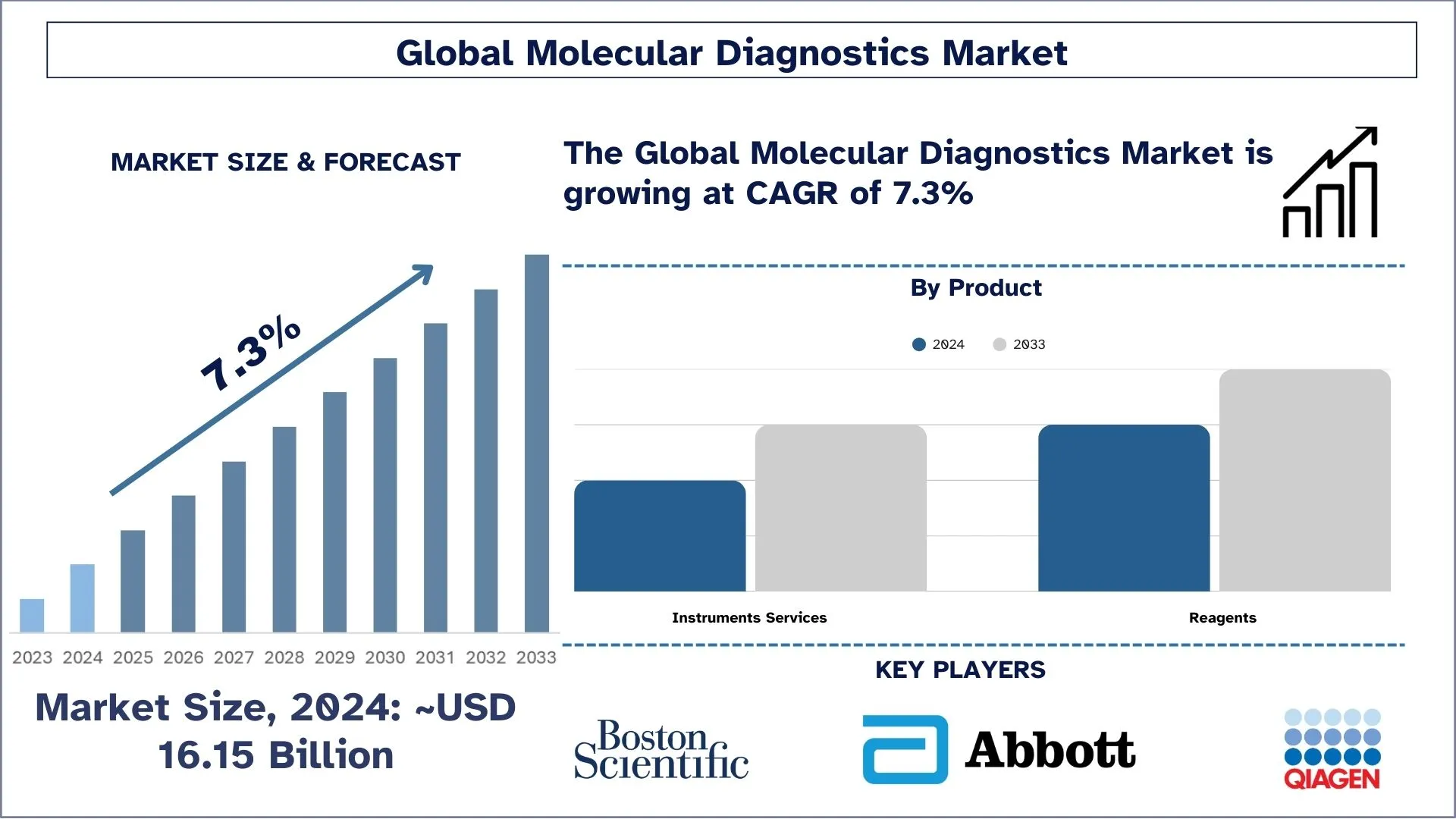
Molecular Diagnostics Market Size & Forecast
The molecular diagnostics market was valued at approximately USD 16.15 billion in 2024 and is expected to grow at a substantial CAGR of around 7.3% during the forecast period (2025-2033), owing to the rising demand for early and accurate disease detection.
Molecular Diagnostics Market Analysis
Molecular Diagnostics is the detection of genomic variants, aiming to facilitate detection, diagnosis, subclassification, prognosis, and monitoring response to therapy. The market of Molecular Diagnostics market is anticipated to grow enormously owing to factors such as rising geriatric population, increasing prevalence of chronic diseases, increasing adoption of Point-of-care diagnosis, advances in genomics and proteomics, and introduction of technologically advanced products. The growing incidence of infectious diseases and cancer is increasing the demand for molecular diagnostics techniques. The rapid advancements witnessed in molecular biology technologies, the development of molecular diagnostic technologies to automated processes, and growing awareness about molecular diagnostics usage for the detection of different diseases in developing countries are boosting the overall market growth. The investment in unifying technology, consolidation and automation of labs, and a shift to data-driven healthcare will mark a trend in this industry. However, high prices of molecular diagnostics tests and unfavourable reimbursement policies will act as the major challenges in the growth of this market.
Molecular Diagnostics Market Trends
This section discusses the key market trends influencing the various segments of the Molecular Diagnostics market as identified by our research experts.
Shift Toward Rapid Point-of-Care Molecular Diagnostics
The molecular diagnostics sector experiences quick changes through increasing applications of point-of-care testing as well as rapid molecular diagnostic methods. Medical innovations deliver rapid, accurate diagnostic results beyond laboratory settings, which provides improved patient results at lower healthcare expenses. Strict rules of multiplex testing, along with cartridge-based PCR methods, increasingly determine essential clinical management of infectious diseases as well as oncology and genetic disorders through efficient result processing. The rising demand for fast and portable testing has led companies to invest in these technologies to maintain their standing in competitive markets and improve healthcare delivery efficiency.
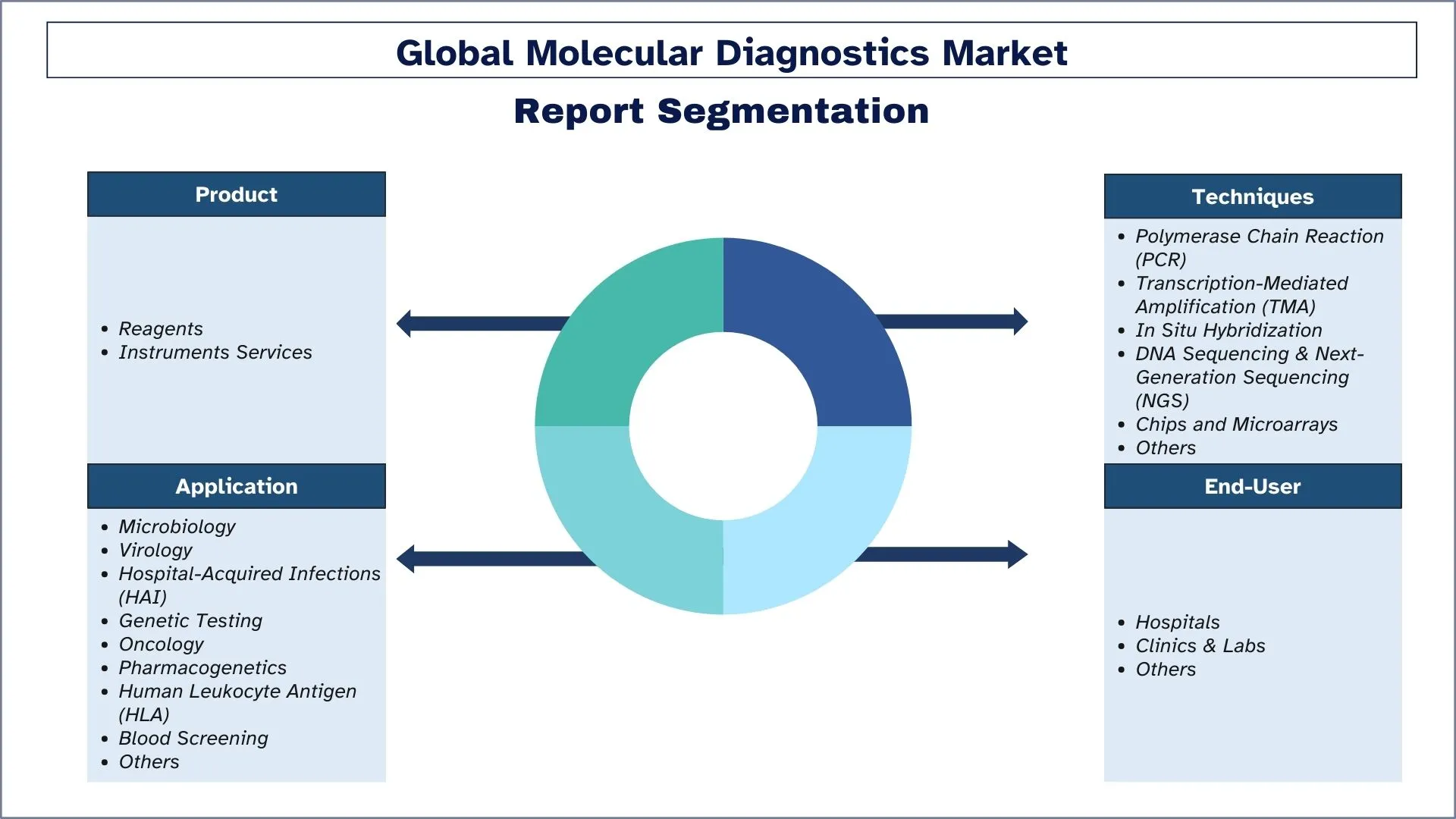
Molecular Diagnostics Market Industry Segmentation
This section provides an analysis of the key trends in each segment of the global Molecular Diagnostics market report, along with forecasts at the global, regional, and country levels for 2025-2033.
The Reagents Segment is Expected to Witness a Higher CAGR than the Molecular Diagnostics Market.
Based on product type the global molecular diagnostics market is bifurcated into Instruments, Reagents and services and others. The market of the Reagents segment is expected to grow tremendously and is projected to dominate the market in 2024 due to the high demand for over-the-counter diagnostic tests, and the rise in adoption of these tests in nonmedical facilities, such as home.
The Polymerase Chain Reaction (PCR) Segment Holds the Largest Share of the Market.
The molecular diagnostics market, based on technique is segmented into Polymerase Chain Reaction (PCR), Transcription-Mediated Amplification (TMA), In Situ Hybridization, DNA Sequencing & Next-Generation Sequencing (NGS), Chips and Microarrays and others. The PCR segment occupied the largest share and is expected to maintain its dominance throughout the forecast period, owing to the increased usage and advancements in PCR techniques.
North America has a significant share of the market in 2024.
The molecular diagnostics sector in North America demonstrates steady market growth because healthcare providers seek early disease identification and personalized medicine options, and technological innovations continue to develop. The market accepts rapid molecular testing methods in addition to point-of-care diagnostics, which speed up and enhance medical diagnosis through non-traditional laboratory settings. Market development happens because of rising healthcare awareness, together with enabling healthcare policies and reimbursement systems. Both the U.S. and Canada have jointly contributed to substantial market growth in the region, where the U.S. holds the lead position.
U.S. Dominates the North American Molecular Diagnostics Market
A rapid market expansion is observed in the U.S. molecular diagnostic sector because innovation in diagnostic technology produces PCR alongside next-generation sequencing (NGS) and CRISPR-based diagnostics. Progressive technical advancements are needed to address the growing need for faster and more precise diagnostic tools because chronic diseases like cancer and infectious diseases, along with genetic disorders, keep becoming more abundant. Personalized medicine coupled with companion diagnostics directs the future of U.S. healthcare while creating vital prospects for corporations and investors operating in this domain. The market continues to expand because of strong regulatory backing, along with growing healthcare facilities.
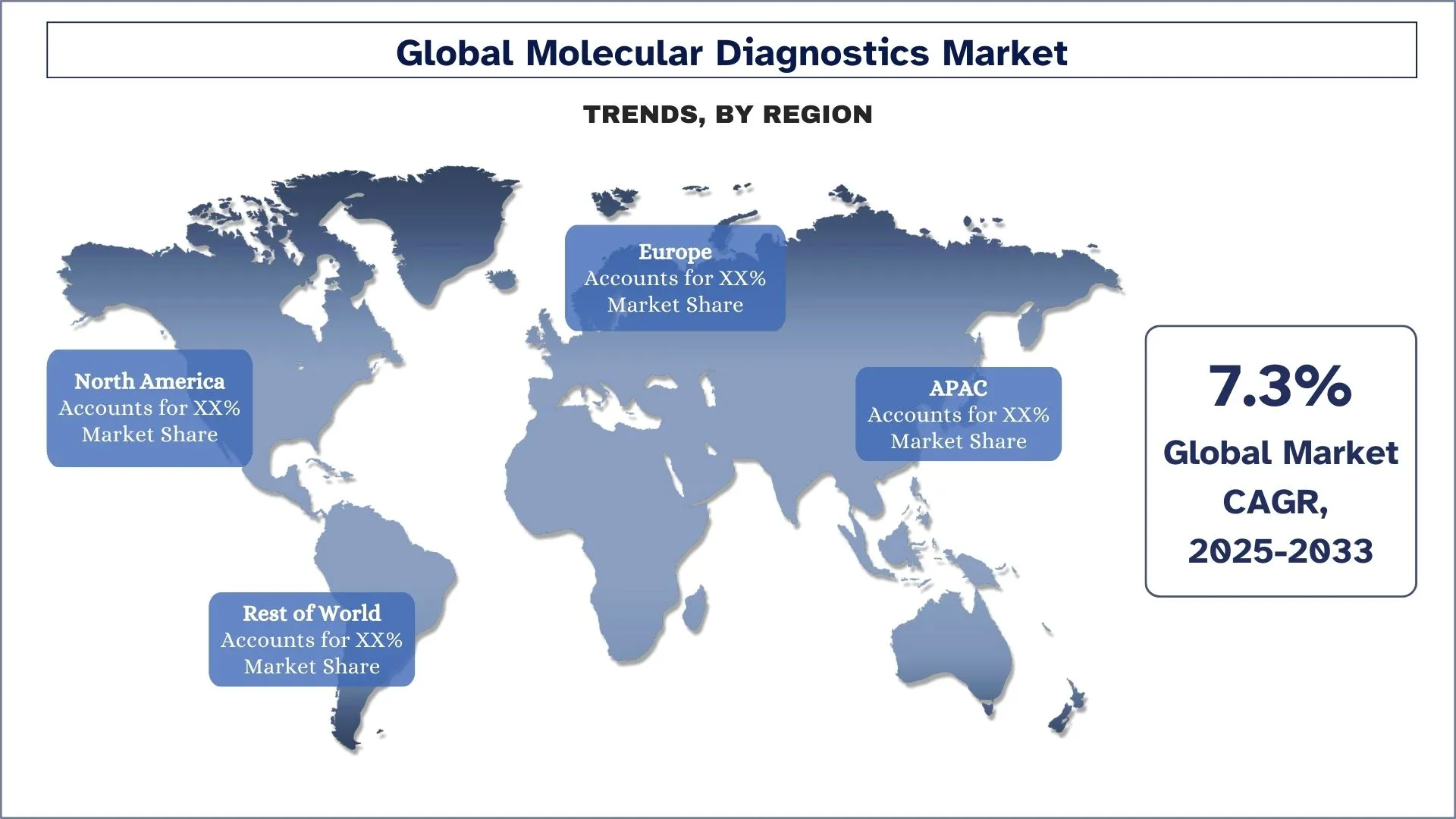
Molecular Diagnostics Market Industry Competitive Landscape
The molecular diagnostics market is competitive, with several global and international players. The key players are adopting different growth strategies to enhance their market presence, such as partnerships, agreements, collaborations, new product launches, geographical expansions, and mergers and acquisitions.
Top Molecular Diagnostics Market Companies
Some of the major players operating in the market are Abbott Laboratories, BD, Biomerieux SA, Danaher Corporation, Hologic, Inc., Qiagen, Roche, Siemens Healthineers AG, Sysmex Corporation, and Thermo Fisher Scientific.
Recent Developments in the Molecular Diagnostics Market
March 2021 – Roche and GenMark Diagnostics entered into a merger agreement for Roche to acquire GenMark completely. By acquiring the company, GenMark’s syndromic panel testing portfolio will supplement Roche’s current molecular diagnostics portfolio.
March 2021 - QIAGEN N.V. announced the launch of the QIAcube Connect MDx, an adaptable platform for automated sample processing to be available to molecular diagnostic laboratories in the U.S. and Canada and other markets globally.
April 2020 – BD, a medical technology company, and BioGX Inc., a molecular diagnostics company, made an announcement of submitting the Emergency Use Authorization requests for the approval of new diagnostic test to U.S. Food and Drug Administration (FDA) which when approved will allow hospitals to screen for COVID-19 and get the results in three hours.
Molecular Diagnostics Market Report Coverage
Details | |
Base year | 2024 |
Forecast period | 2025-2033 |
Growth momentum | Accelerate at a CAGR of 7.3% |
Market size 2024 | USD 16.15 Billion |
Regional analysis | APAC, Europe, Asia-Pacific, Rest of the World |
Major contributing region | North America is expected to grow at the highest CAGR during the forecasted period. |
Key countries covered | U.S., Canada, Germany, France, UK, Spain, Italy, China, Japan, and India |
Abbott Laboratories, BD, Biomerieux SA, Danaher Corporation, Hologic, Inc., Qiagen, Roche, Siemens Healthineers AG, Sysmex Corporation, and Thermo Fisher Scientific | |
Report Scope | Market Trends, Drivers, and Restraints; Revenue Estimation and Forecast; Segmentation Analysis; Demand and Supply Side Analysis; Competitive Landscape; Company Profiling |
Segments Covered | By Product, By Techniques, By Application, By End-Users, By Region/Country |
Reasons to Buy the Molecular Diagnostics Market Report:
The study includes market sizing and forecasting analysis validated by authenticated key industry experts.
The report presents a quick review of overall industry performance at a glance.
The report covers an in-depth analysis of prominent industry peers with a primary focus on key business financials, product portfolios, expansion strategies, and recent developments.
Detailed examination of drivers, restraints, key trends, and opportunities prevailing in the industry.
The study comprehensively covers the market across different segments.
Deep dive regional-level analysis of the industry.
Customization Options:
The global molecular diagnostics market can be customized further as per the requirements or any other market segment. Besides this, UnivDatos understands that you may have your own business needs; hence, feel free to contact us to get a report that completely suits your requirements.
Table of Content
Research Methodology for Molecular Diagnostics Market Analysis (2023-2033)
We analyzed the historical market, estimated the current market, and forecasted the future market of the global Molecular Diagnostics Market to assess its application in major regions worldwide. We conducted exhaustive secondary research to gather historical market data and estimate the current market size. To validate these insights, we carefully reviewed numerous findings and assumptions. Additionally, we conducted in-depth primary interviews with industry experts across the Molecular Diagnostics Market value chain. After validating market figures through these interviews, we used top-down and bottom-up approaches to forecast the overall market size. We then employed market breakdown and data triangulation methods to estimate and analyze the market size of industry segments and sub-segments.
Market Engineering
We employed data triangulation techniques to finalize the overall market estimation and derive precise statistical numbers for each segment and sub-segment of the global Molecular Diagnostics Market. We split the data into several segments and sub-segments by analyzing various parameters and trends, including product, techniques, application, end-users, and regions within the global Molecular Diagnostics Market.
The main objective of the Global Molecular Diagnostics Market Study
The study identifies current and future trends in the global Molecular Diagnostics Market, providing strategic insights for investors. It highlights regional market attractiveness, enabling industry participants to tap into untapped markets and gain a first-mover advantage. Other quantitative goals of the studies include:
Market Size Analysis: Assess the current and forecast market size of the global Molecular Diagnostics Market and its segments in terms of value (USD).
Molecular Diagnostics Market Segmentation: The study segments the market by product, techniques, application, end-users, and region.
Regulatory Framework & Value Chain Analysis: Examine the regulatory framework, value chain, customer behavior, and competitive landscape of the Molecular Diagnostics Market industry.
Regional Analysis: Conduct a detailed regional analysis for key areas such as Asia Pacific, Europe, North America, and the Rest of the World.
Company Profiles & Growth Strategies: Company profiles of the Molecular Diagnostics Market and the growth strategies adopted by the market leaders to sustain the fast-growing market.
Frequently Asked Questions FAQs
Q1: What is the Molecular Diagnostics market's current size and growth potential?
As of 2024, the global molecular diagnostics market is valued at approximately USD 16.15 billion and is projected to grow at a CAGR of 7.3% through 2033.
Q2: What are the driving factors for the growth of the Molecular Diagnostics market?
Hospitals, clinics, and patients now prefer faster, highly accurate tests to catch diseases early (especially cancer, infectious diseases, and genetic disorders). This is pushing strong growth in molecular diagnostics.
Q3: Which market has the largest share of the Molecular Diagnostics market by Product?
The Reagents category dominates the global Molecular Diagnostics market by product segment.
Q4: What are the major trends in the Molecular Diagnostics market?
Molecular diagnostics is shifting toward rapid, point-of-care testing, enabling faster diagnosis and treatment. Cartridge-based PCR and multiplex testing are driving this change, improving patient outcomes and reducing healthcare costs.
Q5: Which region will dominate the Molecular Diagnostics market?
The North America region currently dominates the global Molecular Diagnostics market.
Q6: What are the biggest challenges in the Molecular Diagnostics market?
Developing molecular diagnostic tests is expensive and time-consuming, and getting regulatory approvals (like FDA clearance) is a long, strict process, making it tough for companies to innovate quickly.
Q7: Who are the Top players in the global Molecular Diagnostics market?
The leading companies driving innovation in the Molecular Diagnostics market include:
• Abbott Laboratories
• BD
• Biomerieux SA
• Danaher Corporation
• Hologic, Inc.
• Qiagen
• Roche
• Siemens Healthineers AG
• Sysmex Corporation
• Thermo Fisher Scientific
Q8: What are the emerging technologies shaping the future of the molecular diagnostics market?
Emerging technologies like next-generation sequencing (NGS), CRISPR diagnostics, and digital PCR are transforming molecular diagnostics with greater accuracy, speed, and personalized solutions. Additionally, the integration of artificial intelligence is enhancing data analysis and decision-making, providing businesses with a competitive advantage.
Q9: How can businesses and investors benefit from the growing demand for molecular diagnostics in personalized medicine?
The rise of personalized medicine offers businesses and investors opportunities in companion diagnostics and targeted therapies, which align diagnostics with individual genetic profiles. This trend is expected to drive growth in precision medicine, offering substantial returns for investors focusing on genomic-based treatments.
Related Reports
Customers who bought this item also bought

